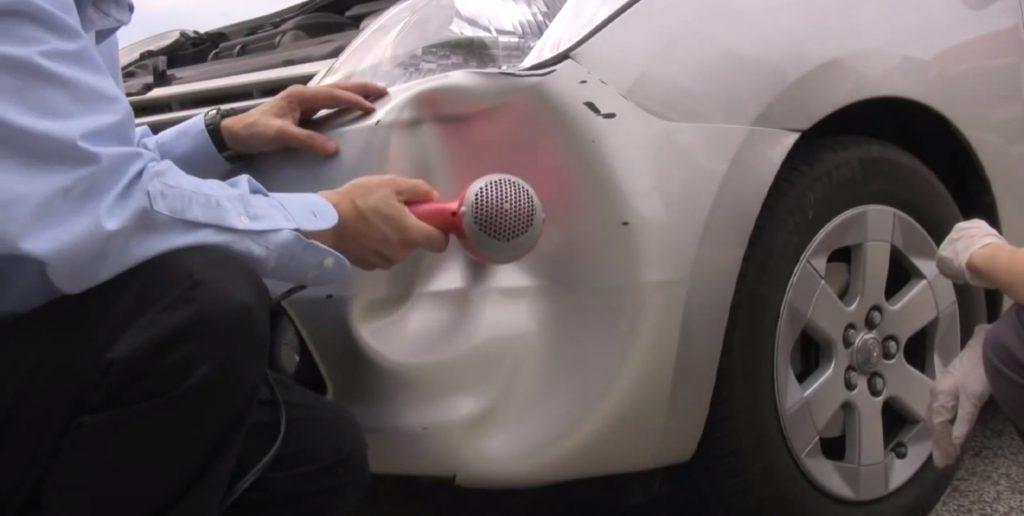No matter how cautiously you drive your car, there is always going to be a clumsy person parking, an out-of-place football, a shopping cart, a fallen tree, or something that would leave its mark on the vehicle. While vintage cars can sport this look quite efficiently, normal cars cannot behave in the same manner. And nobody likes dents and scratches, especially when you have just purchased it. The technical machines play an important role in our lives, from driving to the office/school to planning a road trip, a shiny, well-maintained car makes quite a difference. While you’re supposed to go for MOTs every year and plan regular check-ups, there are a few things you can do at home, with easily available home appliances and patience. Of course, the size and the manner of dent matters when it comes to fixing it at home, but you can always give it a try. The dent repair and car body repair experts at our car dent removal centre explain how to remove dents from metal.
Tips for Car Dent Repair
The first thing that you need to know while going for a DIY car dent repair is the intensity with which that dent was caused. There is a difference between accident damage/warped frame and small indentures that can be fixed at home. If your damage is categorised as accident damage or goes deeper than the plating of your car, you might need to drive to your local accident repair centre and ask for some professional help and hands. The second thing to remember is whether the dent repair can be performed without damaging the paint. For example, paintless dent repair is pretty challenging with an aluminium body but is fairly easier with plastic. It is better to identify whether your body panel, hood, or bumper is made from aluminium, steel, fibreglass, carbon fibre, or any other type. Another thing that matters when it comes to repairing car dents is the manner of the dent. For example, smooth and round outer edges of the dent are easier to repair. On the other hand, if the outer edge is sharp and pointed, it might be more difficult. If you’re looking for paintless car dent removal, you have to remember the heating element. Most of the vehicle that we encounter today has an elastic body, meaning you can easily get rid of the marks and dips without any need for new paint. You just need to heat the body, before you work towards the rest. The logic behind this is that cold paint is brittle and disintegrates easily and quickly. Before you start with the repair of the dent, you should always adequately heat the area to ensure the paint can expand and adapt to the bending and pushing of the metal. The last thing that you should keep in mind before moving on with the car dent repair process is the two-way process that can be employed. You can either pull it from outside or push out from the inside. Of course, the inside mechanism works more efficiently and offers more possibilities for a repair. However, this also entails extensive disassembly. I would advise opting for it only if you’re certain of putting things back. Lastly, before moving on to the DIY methods, remember to be patient during the entire procedure. Any at-home procedure takes time, and won’t work as smoothly as you may see in videos or read here. It’s different for everyone, and will, of course, work if you’re patient.

How to Fix Car Dents?
Let’s start with car dent removal and make our dented vehicle as good as new.
1. Hot Water Method
Heat is the best way to go about when it comes to car dent repair. And before you bring out your toolboxes and big appliances to do the deed, it is easier to just apply heat over the area to see if it will spring back to its original shape. Of course, this works better when the dent is not spread over a large area. Try working with boiling water, and with some luck, the dent will pop all the way back. It might sound too good to be true, but there are multiple testimonies and evidence to show that this actually works. However, remember that the boiling water method only works efficiently with plastic bumpers. And it is advised to splash cold water after it has come back to the original shape, allowing it to set and cool down.
2. Plunger Method
It’s not just a bathroom tool but can also be extremely helpful when it comes to sucking the dent out. And no, we are not unclogging anything here, but just applying its suction properties to the best use. The plunger should be of the cup type (used for sinks) and not as flange one (used for toilets). The idea is to splash hot/boiling water to loosen up the metal and then use the plunger to pull out the dent with a slight pull and strength. This works effectively well for small to medium-sized dents, as larger dents won’t be able to pop-back with just a plunger. Remember to not be very aggressive, and sometimes it needs more than one or two push to get the desired result.

3. Hair Dryer & Compressed air
The ultimate DIY method is to use an infusion of hot air and cold air. To make it as simple as possible, we make use of Hair Dryer and compressed air. The heat helps to expand the plastic allowing the dent to take any other shape, whereas the compressed cold air contracts the plastic, popping the dent out. To do this, simply start by heating the dented area with the hairdryer set at the highest temperature. This will help to expand the plastic of the car. Once you feel that it is heated enough, make use of the compressed air can to spray on the heated area. Make sure the can is turned upside down. The cold air will cause the plastic to contract, allowing the dent to pop out.
4. The Vacuum Cleaner Method
The Vacuum method also makes use of the same suction mechanism as the plunger method but makes for a larger force than the previous method. For this method, you will need a pot (a bucket) and a vacuum cleaner, of course. You would also need some tape to affix the bottom of the bucket to the hose of the cleaner. To do so, make a hole underneath the bucket/pot, enough for the hose to find its way in it. Next, tape the pot/bucket around the dent. Place the vacuum cleaner over the hole and switch it on. This will create a suction environment, which will allow the dent to pop right back.

5. The Dry Ice Method
Not exactly a household item, the dry ice method can be effective to get out small dents from the car. Make sure you’re wearing protective gloves! The process is pretty simple. All you need to do is hold the dry ice on the dent, and rub it around until you hear your dent come back to the surface. You can apply the dry ice as many times as you need to, and you would see the desired result. For a quicker result, you can first heat on the dent with boiling water or hairdryer.
Use Jenkins & Pain, Award-Winning Accident Repair Centre
There you have it, if you do find yourself with damage to your beloved paintwork or kerbed alloys and need a car dent removal, van repair or courtesy car you can count on us to complete all jobs using industry-standard processes. We offer free quotes and with our exclusive repair service, we are sure you will be happy with the results. Contact our Vehicle Body Shop today. Jenkins & Pain are an accident repair centre based in Dover, Kent. We are proud to call ourselves an award-winning accident repair centre. Check out our guide on how to look after your alloys!
Ready to Visit Our Vehicle Body Shop?
We understand how costly and inconvenient it is for a vehicle to be off the road and therefore we use processes that ensure your vehicle is repaired quickly and efficiently. So whether you need minor scratch repairs, major body repair, or alloy wheel restoration, our van body shop and car body shop can guarantee a high-quality service. We also repair light commercial vehicles and motorhomes. Contact us today for a paint repair at our Car Body Shop!


